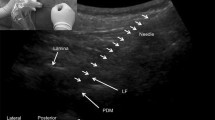Abstract
Background
Caudal epidural block (CEB) is a reliable and effective technique commonly used in pain practice. Having accurate knowledge of sacral anatomy and its anatomical variations is very important for avoiding complications, especially as may occur during dural puncture. This study was undertaken to delineate the anatomical features of the sacrococcygeal region relevant to dural sac (DS) puncture.
Methods
We reviewed magnetic resonance (MRI) images of 1,000 adult patients to determine of the level of termination of the DS, the distance between the upper margin of the sacrococcygeal membrane and the DS, and the presence of incidental dural cystic lesions. Each sacral vertebra was divided into three equal portions (upper, middle, and lower thirds), was defined as a separate region.
Results
The level (26.7 % of all patients) of termination of the DS was most commonly the upper one-third of S2. The DS terminated below the 3rd sacral vertebra in 0.1 % of all patients. No posterior sacral meningocele was seen, but 13 (1.3 % of all patients) had a sacral Tarlov cyst. In three of 13 patients (23 %), the Tarlov cysts terminated below 3rd sacral vertebra level (0.3 % of all patients).
Conclusion
Knowledge of the level of termination of the DS, the distance between the upper margin of the sacrococcygeal membrane and the DS, and the presence of Tarlov cysts on MRI images of before CEB is very important and might decrease the risk of dural puncture.




Similar content being viewed by others
References
Aggarwal A, Kaur H, Batra YK, Aggarwal AK, Rajeev S, Sahni D (2009) Anatomic consideration of caudal epidural space: a cadaver study. Clin Anat 22:730–737
Crighton IM, Barry BP, Hobbs GJ (1997) A study of the anatomy of the caudal space using magnetic resonance imaging. Br J Anaesth 78:391–395
Dalens B, Hasnaoui A (1989) Caudal anesthesia in pediatric surgery: success rate and adverse effects in 750 consecutive patients. Anesth Analg 68:83–89
Desparmet JF (1990) Total spinal anaesthesia after caudal anaesthesia in an infant. Anesth Analg 70:665–667
Friedly J, Chan L, Deyo R (2007) Increases in lumbosacral injections in the medicare population: 1994 to 2001. Spine 32:1754–1760
Joo J, Kim J, Lee J (2010) The prevalence of anatomical variations that can cause inadvertent dural puncture when performing caudal block in Koreans: a study using magnetic resonance imaging. Anaesthesia 65:23–26
Lucantoni C, Than KD, Wang AC, Valdivia–Valdivia JM, Maher CO, La Marca F, Park P (2011) Tarlov cysts: a controversial lesion of the sacral spine. Neurosurg Focus 31:E14
Lumb AB, Carli F (1989) Respiratory arrest after an caudal injection of bupivacaine. Anaesthesia 44:324–325
Macario A, Pergolizzi JV (2006) Systematic literature review of spinal decompression via motorized traction for chronic discogenic low back pain. Pain Pract 6:171–178
Macdonald A, Chatrath P, Spector T, Ellis H (1999) Level of termination of the spinal cord and the dural sac: a magnetic resonance study. Clin Anat 12:149–152
Manchikanti L (2006) Medicare in interventional pain management: a critical analysis. Pain Physician 9:171–197
Markakis DA (2000) Regional anesthesia in pediatrics. Anesthesiol Clin N Am 18:355–381
Mulleman D, Mammou S, Griffoul I, Watier H, Goupille P (2006) Pathophysiology of disc-related sciatica. I-Evidence supporting a chemical component. Jt Bone Spine 73:151–158
Park HJ, Jeon YH, Rho MH, Lee EJ, Park NH, Park SI, Jo JH (2011) Incidental findings of the lumbar spine at MRI during herniated intervertebral disk disease evaluation. Am J Roentgenol 196:1151–1155
Paulsen RD, Call GA, Murtagh FR (1994) Prevalence and percutaneous drainage of cysts of the sacral nerve root sheath (Tarlov cysts). Am J Neuroradiol 15:298–299
Reicher MA, Gold RH, Halbach VV, Rauschning W, Wilson GH, Lufkin RB (1986) MR imaging of the lumbar spine: anatomical correlations and the effects of technical variations. Am J Roentgenol 147:891–898
Schuepfer G, Konrad C, Schmeck J, Poortmans G, Staffelbach B, Jöhr M (2000) Generating a learning curve for pediatric caudal epidural blocks: an empirical evaluation of technical skills in novice and experienced anesthetists. Reg Anesth Pain Med 25:385–388
Senoglu N, Senoglu M, Oksuz H, Gumusalan Y, Yuksel KZ, Zencirci B, Ezberci M, Kizilkanat E (2005) Landmarks of the sacral hiatus for caudal epidural block: an anatomical study. Br J Anaesth 95:692–695
Slipman CW, Shin CH, Patel RK, Braverman DL, Lenrow DA, Ellen MI, Nematbakhsh MA (2002) Etiologies of failed back surgery syndrome. Pain Med 3:200–207
Standring S, Borley NR, Collins P, Crossman AR, Gatzoulis MA, Healy JC, Johnson D, Mahadevan V, Newell RLM, Wigley CB (eds) (2008) Gray’s anatomy, 40th edn. Churchill Livingstone, Edinburgh
Veyckemans F, Van Obbergh LJ, Gouverneur JM (1992) Lessons from 1,100 pediatric caudal blocks in a teaching hospital. Reg Anesth 17:119–125
Conflict of interest
It is declared from all authors that there is no any conflict interest.
Author information
Authors and Affiliations
Corresponding author
Rights and permissions
About this article
Cite this article
Senoglu, N., Senoglu, M., Ozkan, F. et al. The level of termination of the dural sac by MRI and its clinical relevance in caudal epidural block in adults. Surg Radiol Anat 35, 579–584 (2013). https://doi.org/10.1007/s00276-013-1108-2
Received:
Accepted:
Published:
Issue Date:
DOI: https://doi.org/10.1007/s00276-013-1108-2




